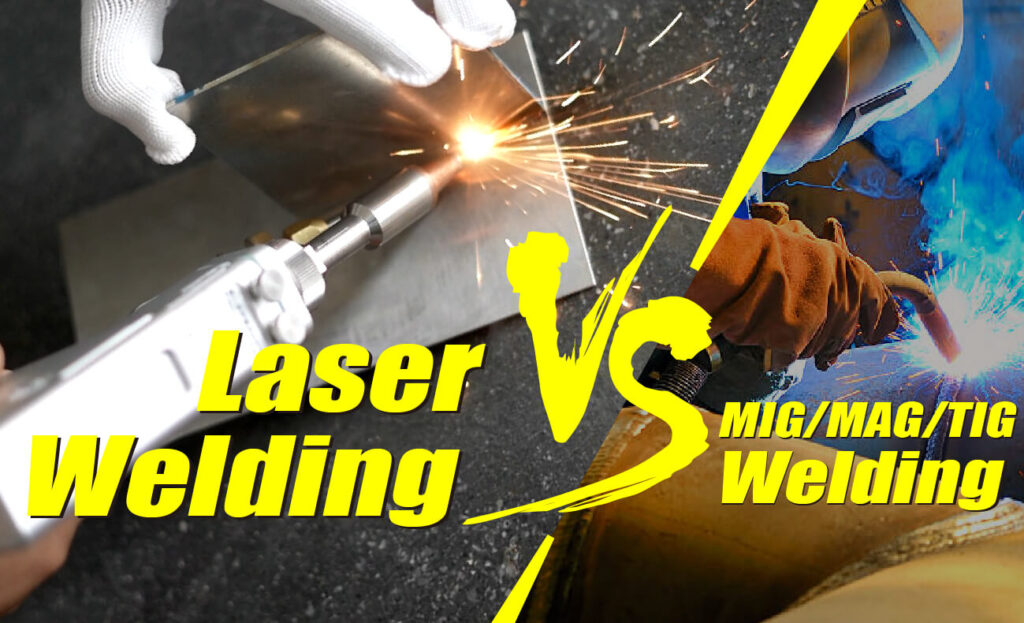In the field of metal manufacturing, traditional welding methods such as MIG, MAG and TIG welding have been widely used, each with unique characteristics and applicable scenarios. However, they also have certain limitations, making fiber laser welding technology gradually popular in many applications. The following are the characteristics and limitations of traditional welding methods, and focus on the advantages and applicable application areas of fiber laser welding.
Characteristics and Limitations of Traditional Welding Technology (1)
MIG welding (Metal Inert Gas)
MIG welding feeds consumable metal wire from the welding gun through an automatic wire feeder, and protects the welding area with inert gas (such as argon). It is suitable for welding thicker materials and is commonly used in fields such as automobile repair and construction. MIG welding is characterized by relatively simple operation and fast welding speed, which is suitable for mass production. However, MIG welding is prone to spatter in high-precision demand scenarios, and the surface quality of the weld is rough, requiring subsequent cleaning.
MAG welding (Metal Active Gas)
MAG welding is similar to MIG welding, but uses active gases (such as carbon dioxide) to protect the welding area. Active gases can enhance weld penetration, making MAG welding suitable for thicker low-alloy steels. Although MAG welding can achieve deeper penetration, active gases can easily cause oxidation in the weld zone, and the weld quality is relatively poor, especially for high-alloy materials, which are prone to corrosion and welding defects.
TIG welding (Tungsten Inert Gas)
TIG welding requires holding a welding wire, using a tungsten electrode to generate an arc, heating the metal and forming a weld under the protection of an inert gas (such as argon). Its weld quality is high, the molten pool is clean, and there is no oxide after welding. It is very suitable for precision welding and is widely used in aerospace and electronic manufacturing. However, TIG welding is slow, requires high-skilled operation, and is not suitable for large-scale automated production.
Advantages of Fiber laser welding
Fiber fiber laser welding technology, with its high precision, high efficiency and flexibility, has demonstrated advantages that traditional welding cannot match in many scenarios:
High-precision, low heat-affected zone
The high energy density of fiber laser welding makes its heat-affected zone extremely small, reducing material deformation and thermal stress, and is particularly suitable for welding thin metals and precision parts. Traditional welding methods such as MIG and MAG have large heat-affected zones and are prone to material deformation .
Fast speed and high production efficiency
Fiber laser welding is much faster than traditional welding methods. Especially on automated production lines, fiber laser welding can complete welding at high speed and high efficiency. This makes it very suitable for batch and automated assembly line applications .
High weld quality and smooth surface
Fiber laser welding can form a smooth weld surface with almost no spatter and is not easy to oxidize after welding. This reduces the need for post-weld cleaning and is particularly suitable for demanding materials such as stainless steel and aluminum. Conventional MIG and MAG welding usually requires cleaning and subsequent treatment .
High flexibility, suitable for complex structures and hard-to-reach locations
The non-contact and small spot size of fiber laser welding enables welding of complex structures and hard-to-reach locations. The laser can be precisely focused by optical fiber and lenses, suitable for deep hole welding and welding in space-constrained areas. In contrast, traditional welding electrodes have difficulty entering these small welding areas .
Wide material adaptability
Fiber laser welding can weld a variety of metal materials, including high-alloy steel, stainless steel and aluminum alloy, and can even connect dissimilar metals, suitable for complex working conditions. However, traditional MAG welding has defects on high-alloy materials and has limited applicability .
Suitable applications for fiber laser welding
Fiber laser welding is widely used in some extremely demanding industries due to its high efficiency, precision and low heat impact. For example, in automobile manufacturing, fiber laser welding is used for high-strength connections of body structures, chassis and key safety components, providing the dual advantages of lightweight and high strength, and improving the safety and fuel efficiency of vehicles. In the aerospace field, fiber laser welding technology can be used for precision welding of lightweight, high-strength alloys, suitable for aircraft frames and engine components, ensuring the durability and corrosion resistance of welded parts.
In electronic manufacturing, fiber laser welding is widely used in the welding of micro-metal parts such as mobile phone casings, precision electronic components and battery connections due to its fineness, which helps to improve the aesthetics and protection of products. In the field of medical devices, fiber laser welding provides pollution-free seamless welding, which is often used in the manufacture of high-demand surgical instruments, implants and precision medical components to ensure the cleanliness and durability of welds. These application scenarios fully demonstrate the excellent performance and reliability of fiber laser welding in modern manufacturing, and have become the preferred technology for high-quality welding.
For more information about fiber laser welding, please don’t hesitate to reach out to us at Contact Us.
(1) https://sheetmetalindustries.com/tig-mig-and-mag-welding-understanding-the-differences-and-benefits/

